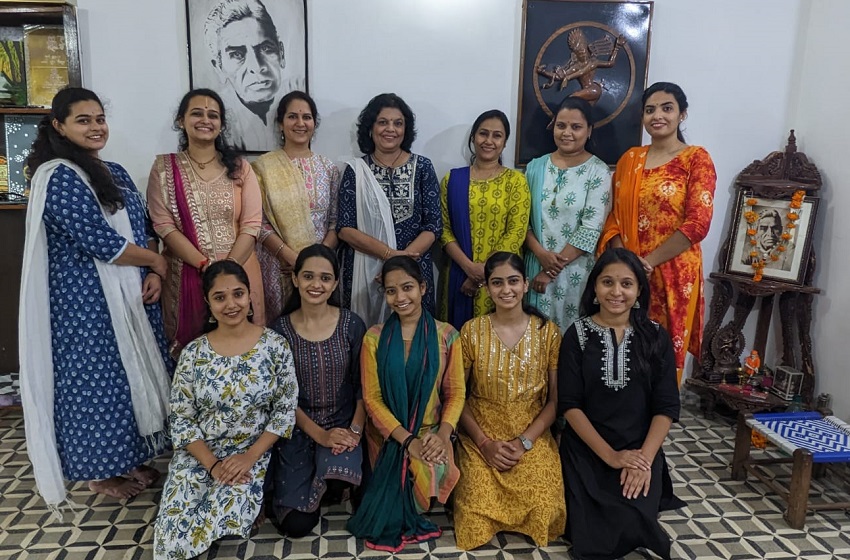‘Vilambit’ is the start of a mehfil. An unhurried unveiling of the raag that is to be presented. Here the raag is slowly and sensuously uncovered bit by bit. A glimpse here, a flash there. Tantalising, exotic. Leisurely the raag form starts taking shape, begins to appear more and more distinct. Eventually, the initial flash of lightning blooms into a full-fledged tempest. The slight disquiet that the glimpse has aroused in us becomes exciting, the tension keeps on building. The mood evoked takes charge of our emotions and despite ourselves we get deeper and deeper into the music, soon nothing else remains but the sound of music.
What is it about music that moves us so? What is it about a sound that affects us to such an extent? Is it because the genesis of the universe was through sound? The big bang! The Vedas too tell us that the universe began with a sound. It says that Parabrahma, the Supreme Being, was quite fed up with being all alone.
‘Ekaki na ramate, ekoham bahu syam’
‘I cannot be entertained all by myself. Let there be many.’
These thoughts created waves. Waves are vibrations and vibrations create sound. So the universe was created with a sound—Aum! Or ‘Big Bang’. In fact, the entire universe is made of vibrations. This is true even down to each individual. Although we exist as separate entities of solid matter, at a much deeper level we are all nothing but interconnecting, inter-penetrating energy fields. Maybe when the vibrations of our energy fields synchronise with those of sound waves, we enjoy music. That may be why the sound is important to us.
Music has a profound and timeless effect on us. We respond to music in our own ways. We listen to music and feel happy, romantic or sad. Sometimes, we choose music either to get us in the mood or to mirror our moods. Even if we may not understand music, at some deeper level music affects us. It is undoubtedly the language of emotions. Musical emotions depend on cognition or how we perceive and remember. Some piece of music is associated in our memory with some event, some emotion. Listening to that music again brings about similar emotions.
Daniel Levitin, a musician and neurologist, proposed another idea about why music gives us pleasure. He says that most of the universe is made up of vibratory patterns. Today science too acknowledges that everything at its most microscopic level consists of combinations of vibrating strands or strings. Human beings are also vibrating and pulsating fields of energy. When a song begins, Levitin says, the cerebellum, which keeps time in the brain, ‘synchronises’ itself to the beat. Part of the pleasure we find in music is the result of something like a guessing game that the brain then plays with itself as the beat continues. As music is patterned over time, the brain attempts to predict where beats will occur. Music sounds exciting when our brains guess the right beat, but the music becomes really interesting when it violates the expectation in some surprising way. The notes breathe, speed up, and slow down just as the real world does, and our cerebellum finds pleasure in adjusting itself to stay synchronised.
However, when this guessing game of brain goes totally out of sync, or when the music continuously keeps hitting the least likely notes, we can get irritated. Good music thus needs to have a fine balance of these expected and unexpected notes. The unique quality of Hindustani art music is that it has tremendous scope for this kind of variation and balance. The structure of this music is such that within a few rigid rules, it has a very flexible and pliable structure.
Probably this is the most interesting distinction between the Western and the Indian classical traditions—the facility of improvisation. In Hindustani art music, each performance is improvised on the spot, making it unique. The same vocalist can sing the same composition in a different way every time. Even a legend like Pt Bhimsen Joshi has said that he cannot replicate a performance completely. The potential of creation is enormous. Hindustani music also provides great scope for melodic innovation, for improvisation, for producing innovative lyrics, for producing unusual timbres when singing, or playing an instrument.
Yet another interesting fact is that the accompanying musicians may not even be aware of what exactly the main solo performer is going to play. But they recognise the music and accompany the soloist as they should. All together they improvise complex passages and create awesome multi-layered music in a cohesive whole that brings out the mood it is meant to and takes the audience along with them. If the listeners are knowledgeable about music, they are supremely affected, and even if some do not know anything about Hindustani art music, it has the power to have a similar effect on them.
This phenomenon has nothing to do with mysticism or spirituality. It is the way a pleasurable sound can affect you. That does not mean there is no element of spirituality in Hindustani art music. Like all arts in India, even music has its genesis in spirituality and religion. However, you cannot suddenly become spiritual just by listening to this music. You may, however, get emotionally affected and profoundly moved. Some listeners are moved to tears—such is the beauty of this melodic sound suffused with sentiments. If this is the effect Hindustani music can have when you do not know much about it, can you imagine how intense the effect will be if you understand the concepts?
Excerpt from Nuances of Hindustani Classical Music by Hema Hirlekar









